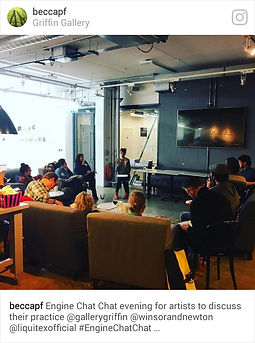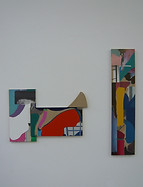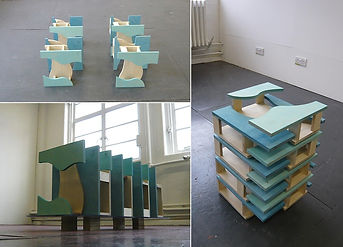Objects in any form have the spatial qualities to examine and extend in artistic approach. Investigating the structure of space and relations of things around, my art practice has been about dealing with space and object as a whole structure. In the perception of space as the capacity of emptiness like stage or façade, I examine the possible modulation or construction of space in objects and extend into surrounding space of it. Then in my work, I try to build its own inner/outer-scape by framing objects in space.
-Sensing space in phenomenology
"The landscape thinks itself in me and I am its consciousness." –Cezanne

My artistic aspiration to objects in space relates to observative perception rather than indexical signification. Gaston Bachelard’s The Poetics of Space (▷further writing) has been the core reference to visualise my idea of space and read the concept of a house in dream geometry.
Additionally, it helped interpret artists’ inner state of mind like de Chirico and Fontana who worked on the spatial theme. In Phenomenology of Perception (Merleau-Ponty), the mutual relation between subject and object explains the way of sensing spaces.
“The object of perception is immanently tied to its background—to the nexus of meaningful relations among objects within the world. Because the object is inextricably within the world of meaningful relations, each object reflects the other. Through involvement in the world – being-in-the-world – the perceiver tacitly experiences all the perspectives upon that object coming from all the surrounding things of its environment, as well as the potential perspectives that object has upon the beings around it.”
In the relation to Bachelard’s interpretation of house in ontology and phenomenology, spatial quality of house in phenomenological perception also found in the essay: John Berger, The Meaning Of Home. (<- click to see the text)
-Framing space
“Art is always the matter of the ‘frame’ or ‘framing’… …It is the frame that produces a ‘becoming’ in holding two such sensations together… …that allows us put the pieces of ‘two differently oriented planes’ together to form what they call a ‘house’.”
Deleuze and Guattari, What Is Philosophy?
Studio space where I carry on my practice has become the 2nd habitat of daily life in London. Like a house, it is the place sheltering me and the object that I observe on daily basis. Studio space also becomes gallery space. In thinking of gallery space, the structure of walls, corner and ceilings, I wanted to bring structure and volume of the exhibiting space into the spatial form of my sculpture.
For example, stairways at Saatchi surrounded by external walls between buildings, which becomes the interior of gallery space. Likewise, I wanted to make space to observe and be observed, space to experience around.


gallery space, Sadie Col HQ
-miniature vs human scale
Miniature has the property of an object and space at the same time as drawers do.
When I make table size pieces, I imagined the garden or stage of them I can wonder around. On the other hand, making in a bigger size, I consider building them like miniatures. Thinking about the inversion of scale gives me the room to develop structures.
“… an experience of topophilia; that is, once, inside the miniature house, he sees its vast number of rooms; from the interior, he discovers interior beauty. Here we have an inversion of perspective, which is either fleeting or captivating…”
Bachelard, The Poetics of Space
Also, while making small parts for joining or fixing big pieces of wood together, I wanted each of them to be sort of independent miniatures.




-matter and memory
Memory in my practice is fragments of the image about the ambience of places, the lines of walls and ceilings, architectural construction in recollection like an afterimage. Then memory acts as material to translate into fictional structures.
“Wherever we are trying to recover a recollection, to call up some period of our history, we become conscious of an act sui generis by which we detach ourselves from the present in order to replace ourselves, first, in the past in general, then, in a certain region of the past- a work of adjustment like the focusing of a camera. But our recollection still remains virtual…”
Bergson, Matter and Memory, 1896
-trace of memory and space in the political sense
I believed that bringing politics into my context should carefully take responsibility of my voice because there are real people living in reality behind ideology, theory or social issues. I believed it should start from live experience or related background so deliberately avoid suggesting the topic. However, Ian’s assessment feedback in the 2nd term lingered in my mind asking “who these buildings are for” in my work. It also reminded me that Edwina in Petcha Kucha mentioned Doreen Massey’s quote from her book, For Space: “Space is not neutral but is something intertwined with time and thus ever changing… …The way we think about space matters inflects our understandings of the world, our attitudes to others, our politics.”
In this context, my space is always no man’s land while I define space as an emptiness and capacity only in the relation with objects. It is fine but limited. I have seen my strong curiosity in space interrelated to my personal interest in astronomy and fictional space of literature. Then again I wanted to investigate where it begins regarding the real world as well as the inner state of mind.
I visited Do Ho Suh: Passage/s at Victoria Miro gallery.

Haegyu Yang, Voice and Wind, New Museum, New York, 2010
Do Ho Suh uses the repetitive motive of Hanok (a term of Korean traditional house ▷further writing) like house within house, passages. Haegue Yang uses particular Korean domestics as subject-matter and site address as a title. Both nomad artists engage with particular space and nostalgia, of house. I found the connection with the historical and political circumstance in the past of my country somehow. Modernisation in Korea has accomplished rapidly just in a few decades than any other countries on the globe. My parents’ generation reminds their childhood in naïve and traditional in the pre-modern agricultural environment. Postmodern era and modernism almost came together. Democratic system interlocked cultural tradition, Confucianism, anti-communism and capitalism from the beginning. Industrial society has shifted to post-industrial in 1 or 2 decades. In the circumstances, not only the way of living but also the spaces we live in, habitat, house as dwelling bring different experiences of time and space simultaneously.
Klaus Rinke: Time, Space, Body, Transformations
His work is time-based media but can be read as conceptual sculpture engaged with imprinted body image.
His text(<-click to read the text) about recollection and inspiration from his childhood linked to my childhood in the 80s with parallel experience and memory of sense as his, though Rinke’s circumstance in time demanding was far stricter than mine. So it evokes my memories of sites in childhood, different kinds of a house in traditional and modern style/ private and apartment, small alleys, railway station, landscape, wasteland, old king’s tombs, convent, when places around me became playground then became a cave for imagination then became a shelter. It was the experience intertwined with different time and space.


-Engine Chatchat, Griffin Gallery
Balance and Territory
Participating artists’ talk program across UAL postgraduate students at Griffin Gallery, I brought up the topic of the meaning of space for sharing views from the different background. Interestingly, one of the artists studying in MA Photography came up with the idea of balance and territory (of pink plastic), which I worked for practical reason in making and installation, that both connote political meaning. One as harmonising people’s gathering in space and the other as the border of indoor/ outdoor and they could create energy more than physical presence with the meaning of special purpose.
-Interpretation of living space and people’s territory in the legacy of modernism: Martin Boyce, Nicole Wermers
-Other works
**space in dwellings (▶click to see practice unit2)
+façade and expanded surface
Façade:
Architectural and cultural reference
The psychological interpretation of dream (project subconscious state of mind)
->collage painting: re-ordering fragments of shape & colour onto empty surface
Spatial composition with structure of shape and texture
Since I have focused 3D work recently, I wanted to see painting as the front
of space like façade to project space on it. Façade has become interesting architectural space for me.
Unfolded Series:
As the response to the previous painting, Façades, and the use of plywood, I interrogate the structure on the surface of plywood and expand space based on it. I cut them followed by its grains then made 2 different structures from 2 sheets of the wood. Then it becomes the prototype for 8 combined structures from 8 sheets on the left side in the photo. 4 combined structures from 4 sheets on the right side.
+Stairs
This is one of the series of work about my interpretation in response to The Poetics of Space by Bachelard. Stairs are the passageway from habitat to dreamer’s place like attics or the basement. Arranging several pieces of same structure but in growing form is revealed space by one’s movement. Under the top structure, the structure is more about the sentiment passing by a wall and stepping on stairs. The structures are not fixed. They are stacked one by one using balance.
+cave
To take part in the show in old church gallery, the damp space itself came to me as the image a cave. As a dwelling in the historical time or a playground in my childhood, the gallery space lets me play cave dweller. I found different kind of wood around studio then cut and glue them to build the wooden miniature city for a shelter in a cave.
**Space in objects (▶click to see practice unit1)
+drawers and altered canvas
My interest used to be in painting and object with the modulation of space in the object and extending into the surrounding space of it. It aimed for finding the dimension of intimacy. I started this work from my table in the studio. I used a table top, 2 drawers and chairs around me as the object for painting and as the stage to set my altered canvases. Bringing a drawer as hybrid-object [Bachelard, The Poetics of Space], I wanted to find the illusion of painting not only from the surface of canvas but also by reconstructing space from canvas materials. This work is the final form of the series of studies for painting as an object and canvas as space.





